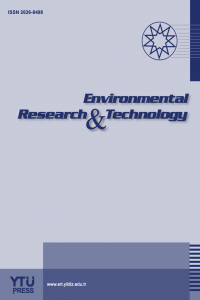Green design or multiple re-useable product packaging as regards solid waste in selected areas in Awka Metropolis, Nigeria
Green design or multiple re-useable product packaging as regards solid waste in selected areas in Awka Metropolis, Nigeria
Awka Metropolis, green design, multiple reuse, product packaging solid waste, zero waste,
___
- Q. Yuan, and L. Y. Tang, “The principles in green design,” E3S Web of Conferences, Vol. 02002(259), pp. 1–6. 2021. [CrossRef]
- M.-L. Tseng, A. S. F. Chiu, R. R. Tan, and A. B. Siriban-Manalang, “Sustainable consumption and production for Asia : sustainability through green design and practice,” Journal of Cleaner Production, Vol. 40, pp. 1–5, 2013. [CrossRef]
- H. Barmaki, “The role of design in sustainable consumption: A study on sustainable food packaging,” [Master Thesis]. Istanbul Technical University, 2012.
- I. D. Paul, G. P. Bhole, and J. R. Chaudhari, “A review on Green Manufacturing : It’s important, methodology and its application,” Procedia Materials Science, Vol. 6, pp. 1644–1649, 2014. [CrossRef]
- M. Y. M. Taib, Z. M. Udin, and A. H. A. Ghani, “The collaboration of green design & technology towards buisness sustainability in Malaysian manufacturing industry,” Procedia - Social and Behavioral Sciences, Vol. 211(2), pp. 237–242, 2015. [CrossRef]
- A. S. Oluyemi, and E. B. Oladumiye, “General appraisal of the nomenclature of non-alcoholic beverages (NAB) brands,” Scholedge International Journal of Multidisciplinary & Allied Studies, Vol. 7(1), pp. 1–13, 2020.
- World Health Organization,“Our planet, our health report of the Commission on Health and Environment, World Health Organization, 1992.
- I. A. Ikhuoria, “Analysis of the special Attributes and chemical methods of solid waste management in Nigeria,” Environmental Reviews, Vol. 4(1), 2002.
- United States Environmental Protection Agency, “Disposal of municipal solid waste,” United States Environmental Protection agency, 2008.
- S. N. Uchegbu, “Issues and strategies in environmental planning and management in Nigeria Enugu,” (1st ed.), Spotlite Publishers, 2002.
- O. B. Ezeudu, C. G. Ozoegwu, and C. N. Madu, “A statistical regression method for characterization of household solid waste : A case study of awka municipality in Nigeria,” MDPI Recycling, Vol. 4(1), pp. 1–17, 2019. [CrossRef]
- S. Onwuka, and U. Ajator, “Evaluation of people’s perception on plastic waste management, a study of Nnamdi Azikiwe University in Awka Anambra State,” International Journal of Environment and Pollution Research, Vol. 6(2), pp. 54–69, 2018.
- M. L. Ozoemene, E. A. Obienusi, and E. E. Ezenwaji, “Evaluation of domestic solid waste disposal in two selected housing estates in Awka, Anambra State (case study of Udoka and Real Estates),” Journal of Environmental Earth Sciences Vol. 4(16), pp. 102–109, 2014.
- V. A. Obi, J. I. Orga, and A. E. Ogadimma, “Effect of solid waste management on sustainability of clean environment that promotes healthy living in Nigeria : A Study of (ASWAMA) Awka, Anambra State of Nigeria,” The NG-Journal of Social Development, Vol. 7(1), pp. 27–48, 2018. [CrossRef]
- U. S. Bill, N. I. Chidi, A. Christopher, and U. Ewuzie, “Survey of waste disposal methods in Awka metropolisJournal of Applied Sciences and Environmental Management, Vol. 19(2), pp. 311–316, 2015. [CrossRef]
- S. Okeke, and C. Anukwonke, “Developing an effective urban waste management system for sustainable environment: A case of Awka Capital territory, Anambra State,” Journal of Environmental Management and Safety, Vol. 7(1), pp. 42–57, 2016.
- A. U. Egbu, H. C. Umunakwe, and C. E. Ogbonna, “Behavioural and household characteristics ınfluencing solid waste generation in Awka, Anambra State, Nigeria,” Journal of Environmental Management and Safety, Vol. 6(1), pp. 1–14, 2015.
- C. Onwuekwe, and A. C. Okoye, “Solid waste management in Awka Metropolis and Public awareness : Sensitizing the populace through the use of social cartoons,” Journal of Environment Pollution and Human Health, Vol. 1(2), pp. 15–23, 2014. [CrossRef]
- E. Güneş, K. G. Bayindir, N. Aydin, and D. I. Çifçi, “Characterisation study of solid wastes : A case of districts in Tekirdağ,” Environmental Research and Technology, Vol. 5(2), pp. 148–154, 2022. [CrossRef]
- E. Görgün, K. A. Adsal, E. V. Aydın, Ç. E. Ergün, N. Keskin, A. Acar, and Ş. Ergenekon, “Deposit refund system for beverage containers as a best practice example for recycling maximization,” Environmental Research and Technology, Vol. 4(3), pp. 199–205, 2021. [CrossRef]
- P. Kamugisha, J. Ludete, and S. Mhanga, “Public private partnerships for successful solid waste management and prospects for reducing public health risks in Kinondoni Municipality-Dar es Salaam, Tanzania,” Environmental Research and Technology, Vol. 2(3), pp. 141–157, 2019. [CrossRef]
- E. B. Oladumiye, A. S. Oluyemi, and O. S. Adelabu, “The visual typicality of non-alcoholic beverage (NAB) package forms in Akure, Nigeria,” Arts and Design Studies, Vol. 66, pp. 615, 2018.
- Yayın Aralığı: Yılda 4 Sayı
- Başlangıç: 2018
- Yayıncı: Yıldız Teknik Üniversitesi
Comparison of waste lithium-ion batteries recycling methods by different decision making techniques
Mahmut ÖZTÜRK, Esra EVİN, Aysun ÖZKAN, Mufide BANAR
Kabour ABDESSELEM, Chebbah LYNDA
Bibliometric analysis of disinfection by-product research trends in Türkiye
Ayorinde OLUYEMİ, Azuka OGBOGU-NZOİWU
Dilek ERDİRENÇELEBİ, Recep YİĞİT
Biodegradation of high cellulose-lignin content agricultural wastes in bioreactors
Yonca KILIÇ, Roda Gökçe YILMAZ ÇİNÇİN, Osman Nuri AĞDAĞ
The effect of bags law on environmental behavior and habits-Mersin example
Mutlu YALVAÇ, Mohammed SALEH, Melis GÜN, Hüdaverdi ARSLAN
Hüdaverdi ARSLAN, Kemal SALİCİ, Melis GÜN, Mutlu YALVAÇ
Waste classification and separation practices from Türkiye and selected countries of the world
Kemal ULUSOY, Neslihan DOĞAN-SAĞLAMTİMUR, Paulina Magdalena SEKUŁA, Andrzej STERNIK
